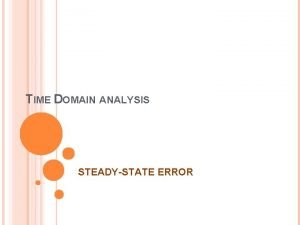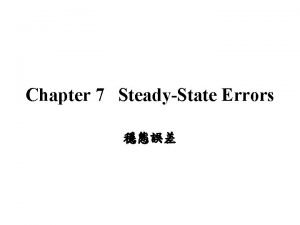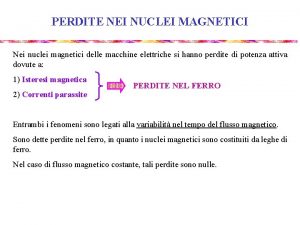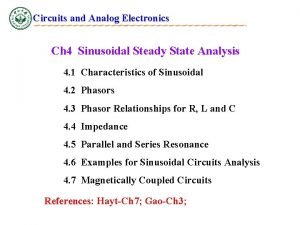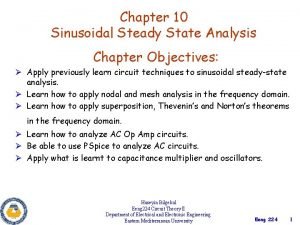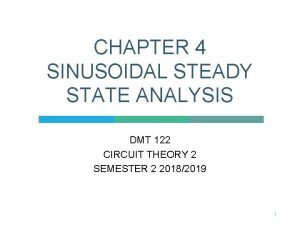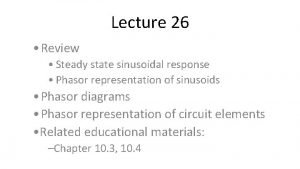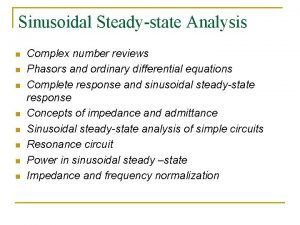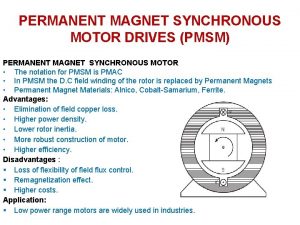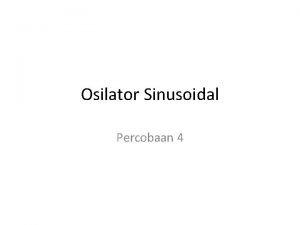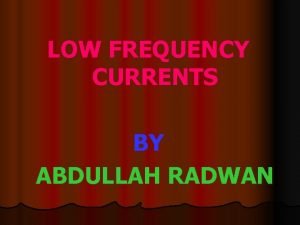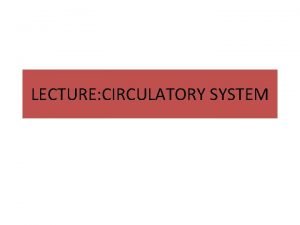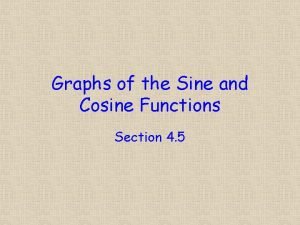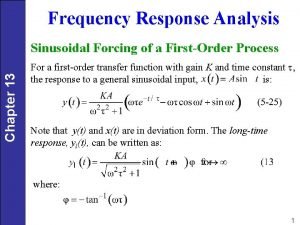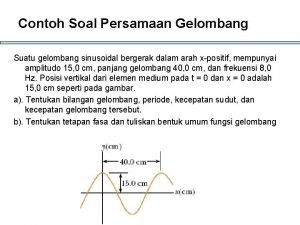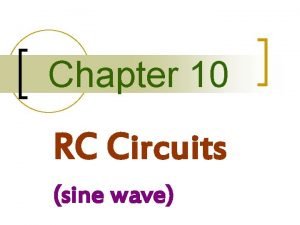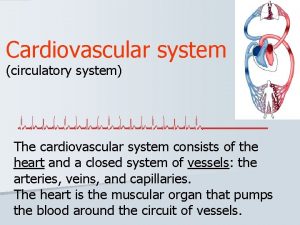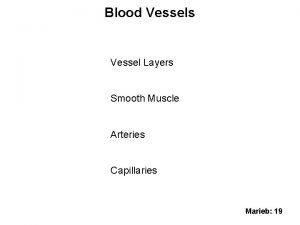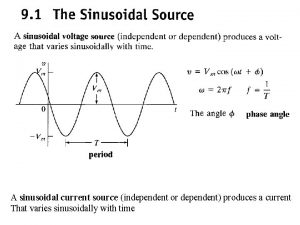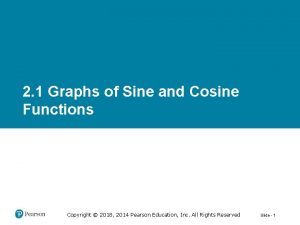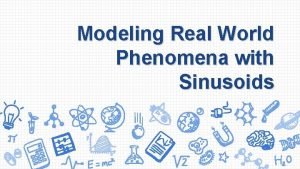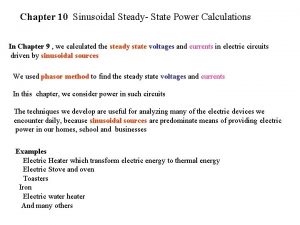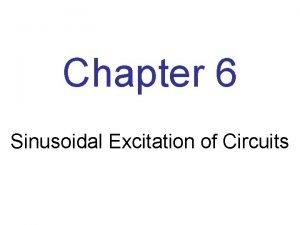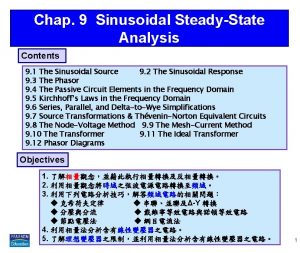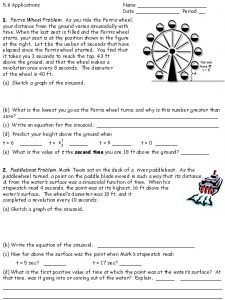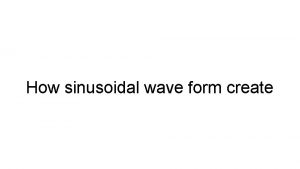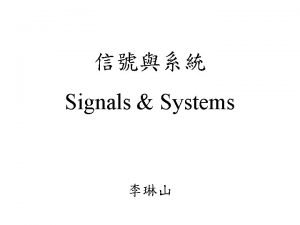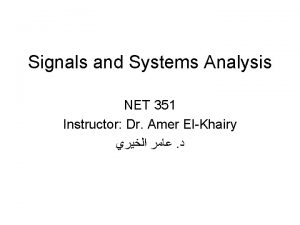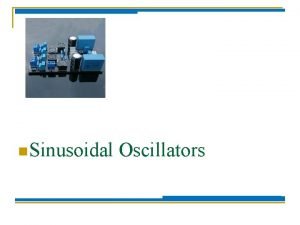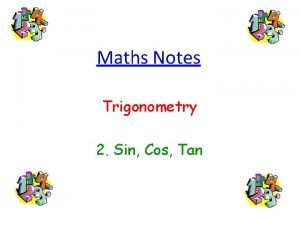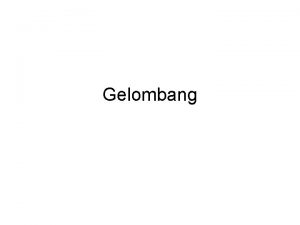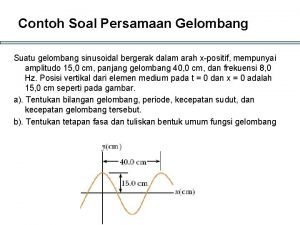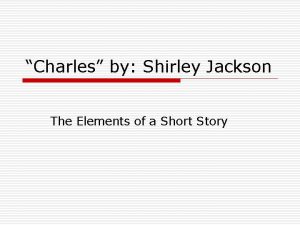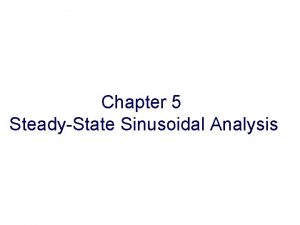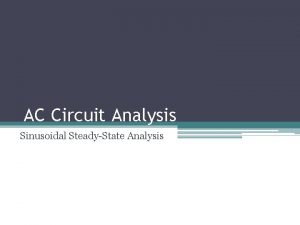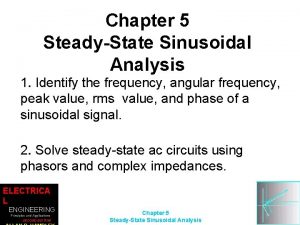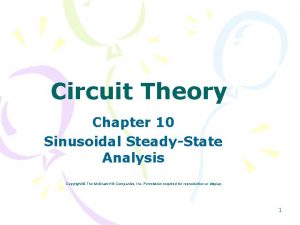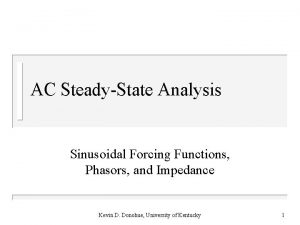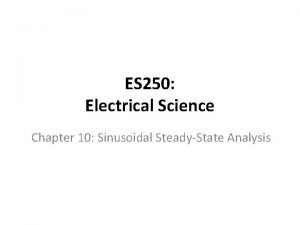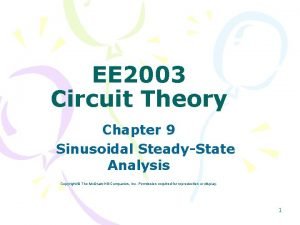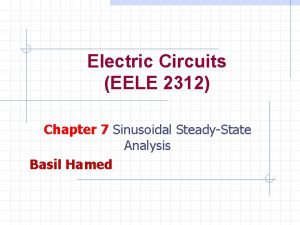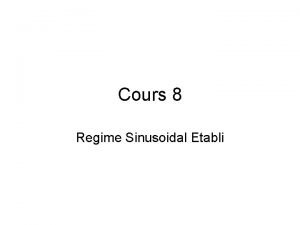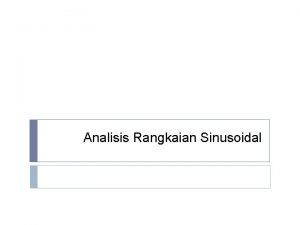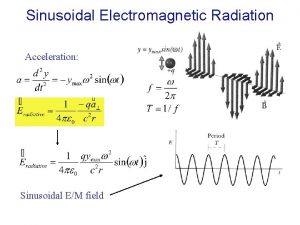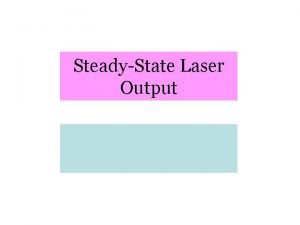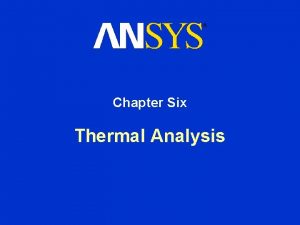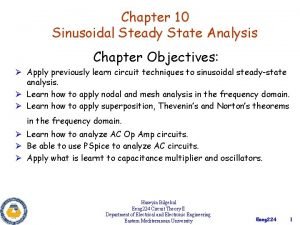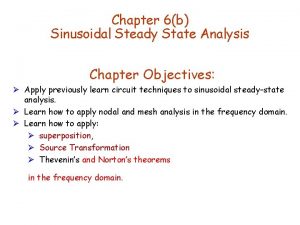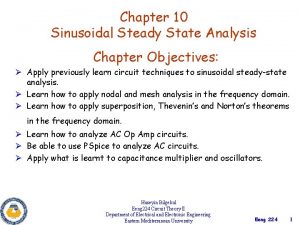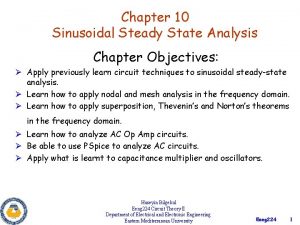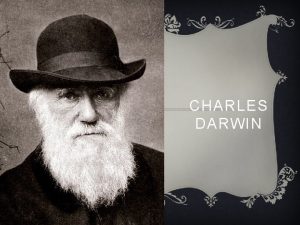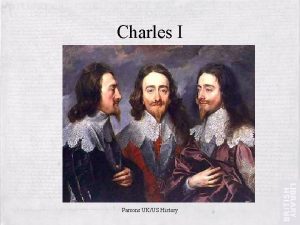Chapter 10 Sinusoidal SteadyState Analysis Charles P Steinmetz






















































- Slides: 54

Chapter 10 Sinusoidal Steady-State Analysis

Charles P. Steinmetz (1865 -1923), the developer of the mathematical analytical tools for studying ac circuits. Courtesy of General Electric Co.

Heinrich R. Hertz (1857 -1894). Courtesy of the Institution of Electrical Engineers. cycles/second Hertz, Hz

Sinusoidal Sources Amplitude Period = 1/f Phase angle Angular or radian frequency = 2 pf = 2 p/T Sinusoidal voltage source vs Vm sin( t ). Sinusoidal current source is Im sin( t ).

Example v i + i circuit v element _ Voltage and current of a circuit element. The current leads the voltage by radians OR The voltage lags the current by radians

Example 10. 3 -1 Find their phase relationship and Therefore the current leads the voltage by

Recall Triangle for A and B of Eq. 10. 3 -4, where C .

Example 10. 3 -2 B A A B

Steady-State Response of an RL circuit An RL circuit. From #8	 Substitute the assumed solution into 10. 4 -1 Coeff. of cos Coeff. of sin Solve for A & B

Steady-State Response of an RL circuit (cont. ) Thus the forced (steady-state) response is of the form

Complex Exponential Forcing Function Input Response magnitude phase frequency Exponential Signal Note

Complex Exponential Forcing Function (cont. ) try We get where

Complex Exponential Forcing Function (cont. ) Substituting for A We expect

Example We replace Substituting ie

Example(cont. ) The desired answer for the steady-state current interchangeable Or

Using Complex Exponential Excitation to Determine a Circuit’s SS Response to a Sinusoidal Source Write the excitation as a cosine waveform with a phase angle Introduce complex excitation Use the assumed response Determine the constant A

Obtain the solution The desired response is Example 10. 5 -1

Example 10. 5 -1(cont. )

Example 10. 5 -1(cont. ) The solution is The actual response is

The Phasor Concept A sinusoidal current or voltage at a given frequency is characterized by its amplitude and phase angle. Magnitude Thus we may write Phase angle unchanged

The Phasor Concept(cont. ) A phasor is a complex number that represents the magnitude and phase of a sinusoid. phasor The Phasor Concept may be used when the circuit is linear , in steady state, and all independent sources are sinusoidal and have the same frequency. A real sinusoidal current phasor notation

The Transformation Time domain Transformation Frequency domain

The Transformation (cont. ) Time domain Transformation Frequency domain

Example Substitute into 10. 6 -2 Suppress

Example (cont. )

Phasor Relationship for R, L, and C Elements Time domain Frequency domain Resistor Voltage and current are in phase

Inductor Time domain Frequency domain Voltage leads current by

Capacitor Time domain Frequency domain Voltage lags current by

Impedance and Admittance Impedance is defined as the ratio of the phasor voltage to the phasor current. Ohm’s law in phasor notation phase magnitude or polar exponential rectangular

Graphical representation of impedance Resistor R Inductor L Capacitor 1/ C

Admittance is defined as the reciprocal of impedance. conductance In rectangular form Resistor Inductor Capacitor susceptance G 1/ L C

Kirchhoff’s Law using Phasors KVL KCL Both Kirchhoff’s Laws hold in the frequency domain. and so all the techniques developed for resistive circuits hold Superposition Thevenin &Norton Equivalent Circuits Source Transformation Node & Mesh Analysis etc.

Impedances in series Admittances in parallel

Example 10. 9 -1 KVL R = 9 W, L = 10 m. H, C = 1 m. F i = ?

Example 10. 9 -2 KCL v=?

Node Voltage & Mesh Current using Phasors va = ? vb = ?

KCL at node a KCL at node b Rearranging Admittance matrix

If Im = 10 A and Using Cramer’s rule to solve for Va Therefore the steady state voltage va is

Example 10. 10 -1 v=? use supernode concept as in #4

Example 10. 10 -1 (cont. ) KCL at supernode Rearranging

Example 10. 10 -1 (cont. ) Therefore the steady state voltage v is

Example 10. 10 -2 i 1 = ?

Example 10. 10 -2 (cont. ) KVL at mesh 1 & 2 Using Cramer’s rule to solve for I 1

Superposition, Thevenin & Norton Equivalents and Source Transformations Example 10. 11 -1 i=? Consider the response to the voltage source acting alone = i 1

Example 10. 11 -2 (cont. ) Substitute

Example 10. 11 -2 (cont. ) Consider the response to the current source acting alone = i 2 Using the principle of superposition

Source Transformations

Example 10. 11 -2 IS = ?

Example 10. 11 -3 ? Thevenin’s equivalent circuit

Example 10. 11 -4 Thevenin’s equivalent circuit

Example 10. 11 -4 Norton’s equivalent circuit ?

Phasor Diagrams A Phasor Diagram is a graphical representation of phasors and their relationship on the complex plane. Take I as a reference phasor The voltage phasors are

Phasor Diagrams (cont. ) KVL For a given L and C there will be a frequency w that Resonant frequency Resonance

Summary Sinusoidal Sources Steady-State Response of an RL Circuit for Sinusoidal Forcing Function Complex Exponential Forcing Function The Phasor Concept Impedance and Admittance Electrical Circuit Laws using Phasors
 Normal nst
Normal nst Steady state error
Steady state error Steadystate error
Steadystate error Steinmetz uniform
Steinmetz uniform Formula di steinmetz
Formula di steinmetz Rebetzin
Rebetzin Amy steinmetz
Amy steinmetz Steinmetz kurs
Steinmetz kurs Jarrod bowditch
Jarrod bowditch Dieter steinmetz
Dieter steinmetz Hugh heftner
Hugh heftner Complex impedances
Complex impedances Sinusoidal steady state analysis practice problems
Sinusoidal steady state analysis practice problems Sinusoidal steady state analysis
Sinusoidal steady state analysis Steady state sinusoidal analysis using phasors
Steady state sinusoidal analysis using phasors Charles luther manson
Charles luther manson Pseudo sinusoidal fetal heart rate pattern
Pseudo sinusoidal fetal heart rate pattern Sinusoidal steady state
Sinusoidal steady state Sinusoidal capillaries
Sinusoidal capillaries Pmac motor magnet
Pmac motor magnet Osilator kuadratur
Osilator kuadratur Faradic coil ppt
Faradic coil ppt Circulatoryy system
Circulatoryy system How to find midline of sinusoidal function
How to find midline of sinusoidal function Sinusoidal response of first order system
Sinusoidal response of first order system Sinusoidal fetal heart rate
Sinusoidal fetal heart rate Rate of energy transfer by sinusoidal waves on strings
Rate of energy transfer by sinusoidal waves on strings Suatu gelombang sinusoidal bergerak dalam arah x positif
Suatu gelombang sinusoidal bergerak dalam arah x positif Sinusoidal response of rc circuit
Sinusoidal response of rc circuit Sinusoidal capillaries
Sinusoidal capillaries Continuous capillaries
Continuous capillaries Sinusoidal pattern examples
Sinusoidal pattern examples Sinusoidal current source
Sinusoidal current source Graph of sine and cosine functions
Graph of sine and cosine functions Sinusoidal function examples in real life
Sinusoidal function examples in real life Proyeksi bonne
Proyeksi bonne Sinusoidal nst
Sinusoidal nst Sinusoidal steady state power calculations
Sinusoidal steady state power calculations Sinusoidal excitation
Sinusoidal excitation Phasor representation
Phasor representation Extraterrestrial being problem sinusoidal
Extraterrestrial being problem sinusoidal Sinusoidal wave
Sinusoidal wave Signal system
Signal system Sinusoidal signal
Sinusoidal signal Sinusoidal oscillators are
Sinusoidal oscillators are How to use cos and sin
How to use cos and sin Continuous capillaries
Continuous capillaries Suatu gelombang sinusoidal dengan frekuensi 500 hz
Suatu gelombang sinusoidal dengan frekuensi 500 hz Kecepatan gelombang
Kecepatan gelombang Kuadrat fungsi sinusoidal
Kuadrat fungsi sinusoidal Function and graph
Function and graph Contoh soal
Contoh soal Charles and keith swot analysis
Charles and keith swot analysis What is the theme of charles by shirley jackson
What is the theme of charles by shirley jackson Endosafe pts cartridges
Endosafe pts cartridges

